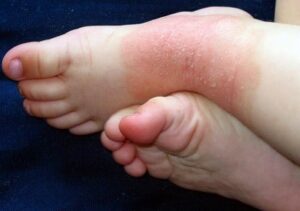Dermatitis on Feet: How to Identify and Avoid Common Triggers
If you’ve ever experienced itchy, inflamed skin on your feet, you might be dealing with dermatitis on feet. This common condition can be quite a nuisance, but with the right knowledge, you can identify and avoid the triggers that cause it. Let’s dive into this step-by-step guide on how to manage foot dermatitis effectively.
Foot dermatitis, also known as eczema on the feet, is a condition that can affect anyone. Whether you’re a busy professional, a parent running after kids, or someone who loves outdoor activities, dermatitis on feet can disrupt your daily routine. This guide aims to help you understand the condition, identify its triggers, and provide practical steps to avoid them. Let’s get started on your journey to healthier feet!

How Can You Identify and Avoid Common Triggers of Dermatitis on Feet?
Step 1: Understanding Foot Dermatitis
Overview:
Foot dermatitis is an inflammatory skin condition that results in red, itchy, and sometimes blistered skin on your feet.
In-depth Instructions:
- Recognize the Symptoms: Common symptoms include redness, swelling, itching, and sometimes blisters or cracks on the skin.
- Identify the Types: There are different types of foot dermatitis, including atopic dermatitis, contact dermatitis, and dyshidrotic eczema. Knowing the type can help tailor the treatment.
Practical Tips:
- Keep a Symptom Diary: Track when and where your symptoms appear to identify patterns.
- Consult a Dermatologist: A professional can provide a definitive diagnosis and recommend treatment.
Quick Exercise:
- Reflect: Have you noticed any particular time or activity that triggers your symptoms? Write it down.
Step 2: Identifying Common Triggers
Overview:
Triggers for foot dermatitis vary from person to person but can include allergens, irritants, and environmental factors.
In-depth Instructions:
- Allergens: Common allergens include certain soaps, detergents, and materials like nickel or latex.
- Irritants: These can be substances that cause direct irritation, such as harsh chemicals or even excessive moisture.
- Environmental Factors: Weather conditions, such as cold, dry air or excessive heat, can also trigger dermatitis.
Practical Tips:
- Patch Testing: Test new products on a small area of skin before using them extensively.
- Avoid Synthetic Materials: Opt for breathable, natural materials in socks and shoes to reduce irritation.
Quick Exercise:
- Inventory Check: Go through your skincare products and note any that might contain potential allergens or irritants.
Step 3: Preventing Foot Dermatitis
Overview:
Prevention involves managing exposure to known triggers and adopting good skincare habits.
In-depth Instructions:
- Moisturise Regularly: Use a fragrance-free moisturiser to keep your skin hydrated.
- Wear Protective Footwear: Avoid walking barefoot in public places to reduce exposure to irritants and allergens.
- Maintain Good Hygiene: Keep your feet clean and dry, especially after exercising or spending time in water.
Practical Tips:
- Choose the Right Footwear: Invest in shoes that provide good ventilation and support.
- Use Hypoallergenic Products: Opt for products labelled hypoallergenic to minimise the risk of reactions.
Engaging Question:
- Consider: What changes can you make in your daily routine to reduce exposure to potential triggers?
Step 4: Managing Flare-Ups
Overview:
Despite best efforts, flare-ups can happen. Managing them promptly can minimise discomfort.
In-depth Instructions:
- Apply Topical Treatments: Use over-the-counter creams or prescribed medications as directed by a healthcare professional.
- Avoid Scratching: Scratching can worsen the condition and lead to infections. Instead, apply a cold compress to relieve itching.
- Remain Hydrated: To keep your skin hydrated, drink lots of water.
Practical Tips:
- Create a Soothing Foot Bath: Soak your feet in cool water with a bit of oatmeal to soothe the skin.
- Rest and Elevate: Elevate your feet to reduce swelling and give them a break from pressure and friction.
Quick Exercise:
- Self-Assessment: How well are you managing your current symptoms? What steps can you take to improve?
Wrap-Up
Foot dermatitis can be challenging, but with the right approach, you can manage and prevent flare-ups. By understanding the condition, identifying triggers, and adopting preventive measures, you can keep your feet healthy and comfortable. Remember, the key is consistency and awareness.
If you’ve found this guide helpful, start implementing these tips today. Keep a close eye on how your feet respond, and don’t hesitate to seek professional advice if needed. Here’s to happy, healthy feet!
Take Control of Your Foot Health Today!
Don’t let dermatitis on feet disrupt your life any longer. Visit Remède to explore our range of expert skincare solutions and find the relief you deserve. Whether you’re looking for personalised advice, high-quality products, or professional treatments, we’re here to help you every step of the way. Click here to start your journey to healthier, happier feet now!

